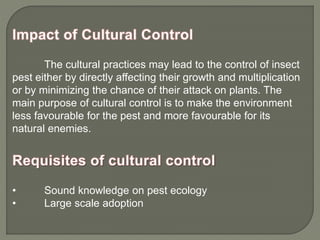Our Pestwise Diaries
Our Pestwise Diaries
Blog Article
Pestwise Can Be Fun For Everyone
Table of Contents4 Easy Facts About Pestwise DescribedThe 5-Minute Rule for PestwiseWhat Does Pestwise Mean?The Main Principles Of Pestwise Facts About Pestwise UncoveredThe Main Principles Of Pestwise What Does Pestwise Mean?

Q. Define "incorporated pest management" (IPM) and list numerous possible control techniques that may be used in an IPM strategy. A. Integrated parasite monitoring is the combining of proper pest control strategies into a single plan to decrease pests and their damage to an acceptable degree. Insect control methods might consist of: host resistance, biological control, cultural control, mechanical control, cleanliness, and chemical (pesticide) control.
How Pestwise can Save You Time, Stress, and Money.
What can you do to maintain the insects you are attempting to manage from becoming immune to the chemicals you make use of? A. Insect resistance can be reduced by using integrated pest administration and revolving the kinds of chemicals utilized.
Parasites are an important threat to the farming company, and integrated bug monitoring aids growers address and mitigate these risks. Integrated bug administration makes use of numerous approaches in facility, therefore being a more reliable solution to the concern. Commercial Pest Control. Particularly, eliminating hostile chemical approaches enables lessening damage to people and the environment by using natural and safer options instead
How Pestwise can Save You Time, Stress, and Money.
The goal of incorporated bug administration is to decrease this damage and control acceptable invasion levels as opposed to eliminate all undesirable populations. This is why it is necessary to comprehend what measures are warranted in each case and usage aggressive ones just when other incorporated management strategies do not work. Integrated administration minimizes the negative repercussions of a non-IPM approach, and the primary benefits of IPM Perks of IPM.
An appropriate understanding of the problem range identifies if the issue needs to be dealt with. are the following parts of an IPM program since it is very important to realize if the microorganisms make possible risks and choose the integrated administration alternatives or the specific pesticide usage. plan to minimize infestations by applying various agronomic techniques.
The Of Pestwise
Integrated monitoring alternatives in an IPM program begin with safer to more hostile ones. The prior integrated management facets assist comprehend how to plan and apply an IPM program action by step: Monitor your plants consistently.

Amongst others, IPM cultural approaches include the complying with area management methods: dirt treatment; choice of appropriate plants; plant rotation; interplanting or strip cropping; selection of planting dates; weed control; use of catch plants. Beneficial dirt problems speed up plant development, and vigorous crops are a lot more resistant to infestations. Healthy plants and seeds determine effective crop development, so it is vital to choose pest-free growing product with strong origins.
, which is also made use of in the incorporated parasite monitoring system. Alternatively, problems raise when plants of the very same plant type or household grow together.
Potato beetles can harm expanding potatoes, in addition to tomatoes. Planting trap plants in spots is an additional alternative for IPM intercropping. This integrated insect management approach recommends drawing in insects to particular plants and after that regulating them with chemical or mechanical strategies. Particularly, you can grow soybeans as catch plants for Japanese beetles.
Some Known Details About Pestwise
Obstacles are case in points of physical IPM approaches. Let's take a description better take a look at them. Eliminating or picking parasites out by hand is a time and labor-consuming option that is commonly applied in incorporated administration and organic farming. Fully grown bugs or their eggs and larvae are gathered by hand and ruined.

Division of Plant Sciences. This incorporated management technique indicates a common way of ruining parasites by predators, parasitoids, microorganisms, and various other biological control representatives (aka antagonistic microorganisms). The role of organic control in IPM is to.
Some Of Pestwise
With time, their populace turned out to be a real nuisance to farmers alongside aboriginal kangaroos or dingoes. The walking cane toad is one more situation illustrating incorporated organic control failing in this respect when it declined to hunt the target varieties and came to be a bug itself. Parasitoids establish on or within their hosts to ultimately kill them after maturing.
Report this page